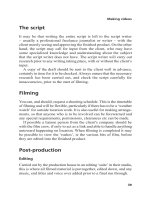CIM revision cards strategic marketing in practice by maggie jones of marketing knowledge
Bạn đang xem bản rút gọn của tài liệu. Xem và tải ngay bản đầy đủ của tài liệu tại đây (359.32 KB, 109 trang )
CIM REVISION CARDS
Strategic Marketing in Practice
Maggie Jones of Marketing Knowledge
AMSTERDAM l BOSTON
PARIS l SAN DIEGO l
HEIDELBERG
SAN FRANCISCO
l
l
l
LONDON l
SINGAPORE
l
NEW YORK
SYDNEY
l
l
OXFORD
TOKYO
Butterworth-Heinemann is an imprint of Elsevier
Linacre House, Jordan Hill, Oxford OX2 8DP
30 Corporate Drive, Suite 400, Burlington, MA 01803
First published 2006
Copyright ß 2006, Elsevier Ltd. All rights reserved
No part of this publication may be reproduced in any material form (including photocopying or storing in any medium by electronic means and whether or not transiently or incidentally to some
other use of this publication) without the written permission of the copyright holder except in accordance with the provisions of the Copyright, Designs and Patents Act 1988 or under the terms of a
licence issued by the Copyright Licensing Agency Ltd, 90 Tottenham Court Road, London, England W1T 4LP. Applications for the copyright holder’s written permission to reproduce any part of this
publication should be addressed to the publisher
Permissions may be sought directly from Elsevier’s Science & Technology Rights Department in Oxford, UK: phone: (+44) (0) 1865 843830; fax: (+44) (0) 1865 853333,
e-mail: permissions @ elsevier.co.uk. You may also complete your request on-line via the Elseiver homepage
(), by selecting ‘Customer Support’ and then ‘Obtaining Permissions’
British Library Cataloguing in Publication Data
A catalogue record for this book is available from the British Library
Library of Congress Cataloguing in Publication Data
A catalogue record for this book is available from the Library of Congress
ISBN-13: 978-0-7506-6769-2
ISBN-10: 0-7506-6769-9
For information on all Butterworth-Heinemann publications visit our web site at
Printed and bound in Great Britain
05 06 07 08 09 10
10 9 8 7 6 5 4 3 2 1
Working together to grow
libraries in developing countries
www.elsevier.com | www.bookaid.com | www.sabre.com
TABLE OF CONTENTS
1.
2.
3.
4.
5.
6.
Preface ..........................................................................
Introduction to Strategic Marketing in Practice ..............................
What is meant by Case Study Analysis? .....................................
Understanding the Direction and Management of Marketing Activities ...
Contemporary Marketing Issues ...............................................
Effective Customer Orientation ................................................
The Examination ................................................................
iv
1
10
33
45
74
93
PREFACE
Welcome to the CIM Revision Cards from Elsevier/Butterworth–Heinemann. We hope you will find these useful to
revise for your CIM exam. The cards are designed to be used in conjunction with the CIM Coursebooks from
Elsevier/Butterworth–Heinemann, and have been written specifically with revision in mind. They also serve as
invaluable reviews of the complete modules, perfect for those studying via the assignment route.
n Learning outcomes at the start of each chapter identify the main points
n Key topics are summarized, helping you commit the information to memory quickly and easily
n Examination and revision tips are provided to give extra guidance when preparing for the exam
n Key diagrams are featured to aid the learning process
n The compact size ensures the cards are easily transportable, so you can revise any time, anywhere
To get the most of your revision cards, try to look over them as frequently as you can when taking your CIM
course. When read alongside the Coursebook they serve as the ideal companion to the main text. Good luck
– we wish you every success with your CIM qualification!
INTRODUCTION TO STRATEGIC
MARKETING IN PRACTICE
Unit 1
LEARNING OUTCOMES
å Identify and critically evaluate marketing issues within various environments, utilizing a wide variety of
marketing techniques, concepts and models
å Assess the relevance of, and opportunities presented by contemporary marketing issues within any given
scenario including innovations in marketing
å Identify and critically evaluate various options available within given constraints and apply competitive
positioning strategies, justifying any decisions taken
å Formulate and present a creative, customer-focused and innovative competitive strategy for any given
context, incorporating relevant investment decisions, appropriate control aspects and contingency plans
å Demonstrate an understanding of the direction and management of marketing activities as part of the
implementation of strategic direction, taking into account business intelligence requirements, marketing
processes, resources, markets and the company vision
STRATEGIC MARKETING IN PRACTICE
1
INTRODUCTION TO STRATEGIC MARKETING IN PRACTICE
LEARNING OUTCOMES – CONTINUED
å Promote and facilitate the adoption and maintenance of a strong market and customer orientation with
measurable metrics
å Synthesize various strands of knowledge and skills from the different syllabus modules effectively in
developing an effective solution for any given context
Aim
Marketing has to be firmly rooted in theory and practice. Practice informs theory and vice versa. Strategic
Marketing in Practice builds on the knowledge and skills developed in the preceding modules, but also looks
for an overall competence in marketing that encompasses all the various subject areas covered in the lower
qualification levels. As marketing is constantly evolving, one of the aims of this module is to explore the latest
trends and innovations relevant to marketers operating at a strategic level within organizations. There is no
specific syllabus for this subject as it is based upon the syllabi for the other post-graduate modules.
2
Analysis and Evaluation – Covers the concepts,
techniques and models involved in developing a
detailed understanding of the market, customers
and competitive environment outside and inside
the organization, its capabilities, and assets, and
opportunities available
Strategic Marketing Decisions – Covers the
concepts, techniques and models involved in
formulating a customer-focused competitive business or corporate strategy and developing a specific
and differentiated competitive position. It includes
investment decisions affecting marketing assets
Managing Marketing Performance – Covers
the implementation stage of the strategy. This
encompasses managing marketing teams,
managing change, implementing strategy through
marketing activites, working with other departments and using measurement as the basis for
improvement.
Analysis and
evaluation
Strategic
marketing
in
practice
Strategic
marketing
decisions
Managing
marketing
performance
Strategic Marketing in Practice and links with other modules.
STRATEGIC MARKETING IN PRACTICE
3
INTRODUCTION TO STRATEGIC MARKETING IN PRACTICE
4
Marketing drives the business agenda
Marketing is a set of activities concerned with creating value for shareholders and other stakeholders by
creating and capturing exceptional value for customers. Organizations expect professional marketers to
develop an increasing sense of ownership for the whole customer experience; this requires them to be
more aware of the operational business agenda.
Professional marketers in publicly quoted or limited companies have to:
n Focus on the long term – While other business functions can maximize economic profit through
efficiency, marketing is the only way to create value. Marketing typically creates three times more
value than other functions.
n Create and Capture value for customers – Marketers create value by increasing the value perceived by
customers in an organization’s products and services. By increasing perceived value, marketers create the
opportunity for premium pricing through which economic profit is increased.
n Take charge of the business agenda – Marketing uses its activities and assets to create customer
value. Shareholders measure the value that the business has created for them as the sum of dividends
paid and increase in share price. Marketing has to take charge of investment in marketing assets and
the activities that create value.
Marketing activities in organizations can be
grouped broadly into four models:
Sales Support
Marketing Communications
Common in SME’s and some B2B contexts, the
emphasis is essentially reactive with marketing
supporting a direct sales force and including
activities such as tele-marketing and responding
to inquiries.
Marketing promotes through push and pull
communications promoting the organization.
More proactive approach uses communication
methods to raise awareness, generate leads
and take orders.
Operational Marketing
Strategic Marketing
Marketing supports the organization with a
co-ordinated range of activities. Planning is at the
operational and functional level. Typically used in
FMCG, B2C and B2B.
Emphasis on creating value and developing a
competitive strategy. Practiced in larger and
customer-focused organizations, with strategic
marketing decisions being made by professional
marketers or business leaders.
STRATEGIC MARKETING IN PRACTICE
5
INTRODUCTION TO STRATEGIC MARKETING IN PRACTICE
6
Marketing contributes to corporate and business plans and develops its own functional plan at an operational
level.
VISION
Analysis
Feedback and iteration
Mission
Statement
Understanding the environment, stakeholders, current position, level of
market orientation, corporate reputation, ethical stance, ecological
stance, market segments served. Organizational competences
technological competences
Objectives
Measurable objectives such as market growth ecological measures,
and financial outputs. Qualitative aspects such as the development of
marketing Competencies, branding effectiveness
Strategies
Utilising models such as Porter, Ansoff, GE Matrix to develop
marketing strategies. Broader political strategies to communicate with
all stakeholders.
Tactics
Short term marketing tactics taking into account current environmental
characteristics, but residing within the overall corporate vision
Control
Summary
Strategic Marketing model for the 21st century.
Marketing metrics, taking into account the different stakeholders that
the company is answerable to
Key aspects of the marketing strategy and contingencies
Areas of focus for SMIP
The SMIP module is designed to test the application of knowledge gained within the other three Post-graduate
modules, alongside the more contemporary marketing issues that affect a range of marketing activities.
These include:
Globalization
Sustainability
Many multinationals have operated globally for years
but technology is driving change, enabling smaller
companies the opportunity of operating globally. The
introduction of the Euro has lead to the development
of pan-European markets .
Increased concerns over climatic change and
environmental deterioration are of critical importance
to marketers. It is important that constraints imposed
by the environment are considered.
Organizational Issues
The culture and nature of the organization, due to
inappropriate structures or personnel, can lead to the
success or failure of the planned marketing strategy.
Constraints
Resources available, either financial or HR related,
can significantly restrict an organization’s ability to
react within its market sector. A sound knowledge
of basic financial statements is essential.
STRATEGIC MARKETING IN PRACTICE
7
INTRODUCTION TO STRATEGIC MARKETING IN PRACTICE
Guidelines for pre-prepared work
Analysis should demonstrate
SMIP students receive the case study four weeks
prior to the examination date.
n The use of models and concepts applied to
the case material
Students are required to produce six pages of
prepared analysis which will be submitted with
the examination script.
n Key issues arising from the analysis of the
case material
25% marks can be awarded for this analysis
as follows:
10% for originality and appropriateness of
pre-prepared analysis
15% for appropriate application of the analysis
within the exam script
n An individual approach to the case study
supplied
n Clear knowledge of the most appropriate
techniques applicable to the case study
organization
8
Revision tips
n Familiarize yourself with the information gained
within the other modules you have studied at
Post Graduate level
n Ensure that relevant financial and
marketing metrics are utilized within the
analysis process
n Familiarize yourself with more operational
concepts at Professional Certificate level that you
may not have studied formally, such as marketing
research and communications planning
n Remember to cross-refer your work in the
examination to the pre-prepared analysis
n Consider the range of contemporary marketing
issues that are applicable to case study
organization and the likely constraints these may
impose
STRATEGIC MARKETING IN PRACTICE
9
WHAT IS MEANT BY
CASE STUDY ANALYSIS ?
Unit 2
KNOWLEDGE AND SKILL REQUIREMENTS
å
å
å
å
å
Analysis, interpretation, evaluation and synthesis of information, including the ability to draw conclusions
Identification, exploration and evaluation of strategic options
Selection and justification of an appropriate option using decision criteria
Establishing the activities, resources and schedule needed to implement the chosen strategy
Working with others to implement and control the strategy
Syllabus Reference: 1.1–1.5
Analysing the case study
Historical events
Analysing the situation the organization finds itself in
through the use of key concepts sourced from the
other post-graduate modules. Detailed and effective
analysis should cover
n The key historical events
It is important to analyse the key critical events which
have shaped the company’s development. Understanding the evolution of an industry and the decisions
made over time can provide a valuable insight into
the organization’s likely capabilities in the future.
n A PESTLE analysis
PESTLE analysis
n A SWOT analysis
To understand the effect of the MACRO environment
upon the industry sector and to highlight key trends.
Includes
n Product marketing analysis
n Issues specific to the case
n Likely constraints
n Any structural features/control issues
n Key issues arising from analysis
n Political factors
n Economic factors
n Social factors
n Technological factors
n Environmental factors
n Legal factors
STRATEGIC MARKETING IN PRACTICE
11
WHAT IS MEANT BY CASE STUDY ANALYSIS?
12
SWOT analysis
Once the previous two stages have been completed, the information to complete a SWOT analysis can be
obtained from Porters 5 Forces Model.
How the SWOT Analysis Helps the Planning Process
Weaknesses
Strengths
C
O
N
V
E
R
T
Converts
Internal to
company
e.g. no. 1 in market place
e.g. poor customer service
Opportunities
Threats
Converts
e.g. competitor dropping from market e.g. new legislation for certain products
External to
company
Porters 5 Forces Model
This model incorporates the effect of the MICRO environment alongside MACRO forces.
Rivalry among existing firms
Goals
objectives
mission
Bargaining power
of buyers
Threat of new entrants
Current
competitive
positioning
Potential
competitive
positioning
Bargaining power
of suppliers
Threat of substitute
products or services
Resultant
position
Industry/Technology
factors
STRATEGIC MARKETING IN PRACTICE
13
WHAT IS MEANT BY CASE STUDY ANALYSIS?
McKinsey’s 7-s model
The internal strengths and weaknesses of the organization can be assessed using the following model.
Structure
Systems
Strategy
Shared
values
Skills
Style
Staff
14
Product market analysis
Many models exist to audit the range of markets, products and services that an organization is involved in.
The first of these is the Product Portfolio model which allows analysis of products or SBUs in terms of the
attractiveness of the market and the organization’s relative position within that market. There are five models
within this category which vary in complexity and applicability.
All can be used as audit tools and for evaluating strategic options later in the planning process.
STRATEGIC MARKETING IN PRACTICE
15
WHAT IS MEANT BY CASE STUDY ANALYSIS?
Boston consulting grid
20
Star
Question mark
Cash cow
Dog
Market growth rate (%)
High
10
Low
0
10
High
1.0
Relative market share
Low
0.1
16
GE matrix
20
Market attractiveness
High
SBU1
SBU2
Medium
SBU3
Low
SBU4
SBU5
0
9
Strong
6
3
Medium
Competitive position
0
Weak
STRATEGIC MARKETING IN PRACTICE
17
WHAT IS MEANT BY CASE STUDY ANALYSIS?
Shell directional policy matrix
Prospects for sector profitability
Unattractive
Average
Attractive
Disinvest
Phased
withdrawal
Double or quit
Company's competitive capability
Weak
Custodial
Phased
withdrawal
Custodial
Try harder
Average
Growth
Cash
generation
Growth
Strong
Leader
Leader
18
Abel and Hammond 3 Â 3 investment opportunity matrix
Competitive position
Medium
ov
er
al
la
ttr
ac
tiv
en
es
s
Lo
w
ttr
ac
tiv
en
es
s
Weak
ov
er
al
la
ttr
ac
tiv
en
es
s
la
al
ov
er
M
ed
iu
m
h
ig
H
Medium
Low
Market attractiveness
High
Strong
Source: Wilson and Gilligan (2006). Strategic Marketing Management (third edition). Oxford: Elsevier.
STRATEGIC MARKETING IN PRACTICE
19
WHAT IS MEANT BY CASE STUDY ANALYSIS?
The Arthur D Little strategic condition matrix
Strong
Favourable
Tenable
Weak
Competitive position
Dominant
Embryonic
• Grow fast
• Build barriers
• Act offensively
Stage of industry maturity
Growth
Mature
• Grow fast
• Aim for cost
leadership
• Defend position
• Act offensively
• Defend position
• Increase the
importance of cost
• Act offensively
Ageing
• Defend position
• Focus
• Consider
withdrawal
• Grow fast
• Differentiate
• Lower cost
• Lower cost
• Differentiate
• Differentiate
• Attack small firms • Focus
• Harvest
• Grow fast
• Differentiate
• Focus
• Lower cost
• Differentiate
• Differentiate
• Attack small firms • Hit smaller firms
• Harvest
• Grow the industry
• Focus
• Hold-on or
withdraw
• Niche
• Aim for growth
• Hold-on or
withdraw
• Niche
• Withdraw
• Search for a niche
• Attempt to catch
others
• Niche or
withdraw
• Withdraw
• Withdraw
Source: Wilson and Gilligan (2006). Strategic Marketing Management (third edition). Oxford: Elsevier.
20









